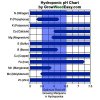Spasticrat
Member
Planning on expanding my grow area next year,
And have been thinking about a ways to implement a better setup.
I had this idea of splitting the buckets (in my case square buckets) with a divider, and then one each side of the divider having separate water for the roots, one side could be kept at a constant 5.8ph , and the other at a constant 6.3.
Then later in the grow with the root in both reservoirs of water, nutrient uptake would be perfect, I wouldn't have to swing the ph around, to allow for ideal uptake of x nutrient.
And this adds a safety buffer to prevent lockout, if one of the reservoirs ph dips or spikes outside of normal for some reason, the plant will still have the other side of the reservoir, that is within normal ph. To prevent lockout.
I know this would be more work, any thoughts?
And have been thinking about a ways to implement a better setup.
I had this idea of splitting the buckets (in my case square buckets) with a divider, and then one each side of the divider having separate water for the roots, one side could be kept at a constant 5.8ph , and the other at a constant 6.3.
Then later in the grow with the root in both reservoirs of water, nutrient uptake would be perfect, I wouldn't have to swing the ph around, to allow for ideal uptake of x nutrient.
And this adds a safety buffer to prevent lockout, if one of the reservoirs ph dips or spikes outside of normal for some reason, the plant will still have the other side of the reservoir, that is within normal ph. To prevent lockout.
I know this would be more work, any thoughts?

